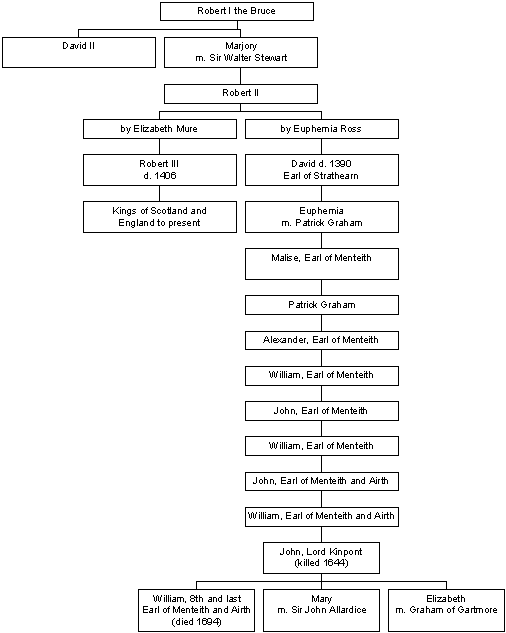APPENDIX 1 - THE ALLARDICE 'CLAIMS' TO ROYALTY AND THE PEERAGEThe
claims of the Barons of Allardice to the earldom of Airth, as heirs of the
Grahams, Earls of Menteith, Strathearn and Airth, are well known to all students
of the British peerage. Put simply,
Robert Barclay-Allardice, as heir general to the Grahams, Earls of Menteith and
Airth, laid claim to the Earldom of Airth. Airth was a subordinate title to the Earldom of
Menteith. Since the Earldom of Menteith was, in the original patent of nobility,
reserved for the heirs-male of the original Graham grantee (i.e., a Graham of
unbroken descent in the male line), the Allardice claim, as heirs in the female
line of the Grahams, did not give them a viable claim to that earldom. Captain Barclay-Allardice's claim was that this Earldom of Airth was, by
the original Royal patent of nobility (issued in 1633), heritable by descendants
in the female line from the grantee. The 1633
Airth grant was issued to the grantee and his "heirs" not "heirs
male," as was the usual custom. Captain
Barclay-Allardice (or, to be more exact, his lawyers) argued before the House of
Lords that the absence of specific mention of "heirs male" meant that
the Airth title could descend in the female line. The Crown argued that "heirs" meant "heirs male";
that the Airth title was intended to be granted under the same terms as the
Menteith patent of nobility, which specified "heirs male."
In 1839 the House of Lords in effect rejected the Allardice claim. For further reading, see History of the Earldoms of Strathearn,
Montieth, and Airth by Sir Harris Nicolas (1842). The Allardice claims were further complicated by various claims of junior
branches of the Graham family to these earldoms, as alleged heirs male of the
Grahams of Menteith. A yet
more curious tale is the claim of the Allardices, through the Grahams of
Menteith, to the Earldoms of Strathearn and Menteith, and indirectly to be the
rightful Kings of Scotland. The
latter claim was never asserted, and of course could not be asserted at such a
late date. The tale
starts with Sir Robert Stewart, later to be King Robert II of Scotland. Sir Robert, nephew and eventual heir of David II of Scotland,
contracted (prior to the time he became heir, and at a time when he had little
hopes of inheriting the crown) a liaison, without benefit of marriage, with
Elizabeth Mure. Out of this union
was, in 1340, born the future Robert III, as well as several other children. Sir Robert later married this Elizabeth Mure, which, under Scottish law,
and with Papal dispensation, served to legitimate the children so born. Naturally, when (in 1371) Sir Robert became king, few were bold enough to
publicly doubt the legitimacy of those children and their right to inherit the
crown. However,
under modern law, and indeed under the laws of most medieval countries, those
children were incapable of inheriting the crown. Under English law, for example, the Beaufort family, born under similar
circumstances, were barred from succession to the throne of Robert's cousin,
Henry IV of England. The opinion
(perhaps self-serving) of the children of Sir Robert Stewart's second, and
indisputably proper, marriage to Euphemia of Ross, was that they were more
entitled to the crown. During the
lifetime of Robert II, his son Robert III and grandson James I, there existed a
rivalry between the two branches of the Stewart family. This
rivalry culminated in 1437 in the assassination of James I by Sir Robert Graham,
a descendant of David, Earl of Strathearn, eldest son of Robert II by his second
marriage. The Grahams of Menteith,
as heirs to this David, were said to be ever conscious of this royal descent, to
the extent that a later Earl of Menteith quartered the royal arms on his coat of
arms. This presumption is said to
have angered James VI (James I of England) by reminding James of his doubtful
ancestry, and caused the King and his earl, once close friends, to become bitter
enemies. In 1633 Charles I (son of
James VI/I) regranted the Earldom of Menteith to the Grahams, under terms that
precluded Graham claims to be heirs of David, Earl of Strathearn, but in partial
compensation created the Earldom of Airth for the Grahams. The last Earl of Menteith died in 1694 and his claims descend to his sister Mary, who married Sir John Allardice of Allardice. Since the crown of Scotland, unlike the Earldom of Menteith, could and did descend through the female line, if David Earl of Strathearn is considered the rightful King of Scotland, the kingdom would descend through his daughter to the Grahams, and through the male line of the Grahams to the Allardices. The following chart illustrates the family lines mentioned here.
|
